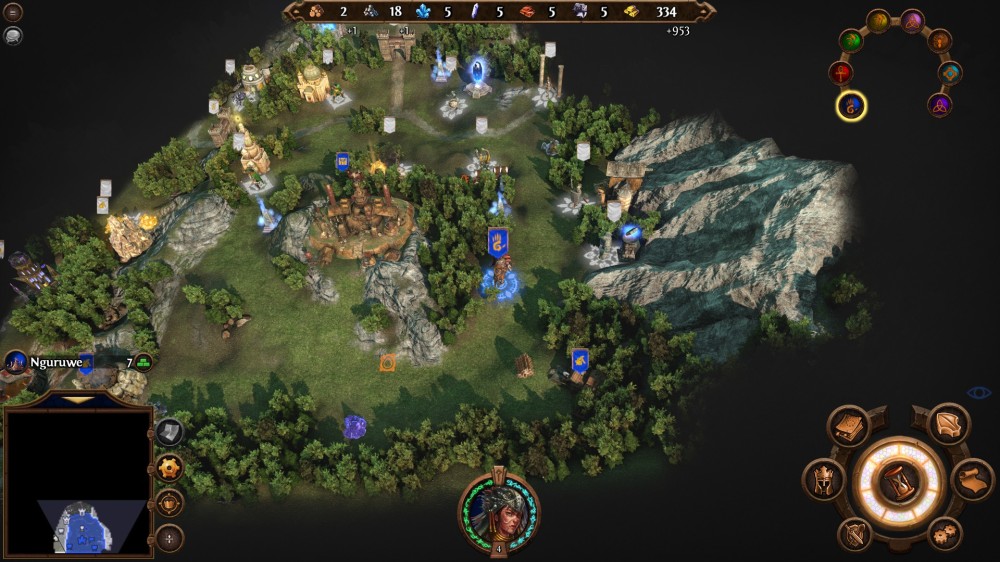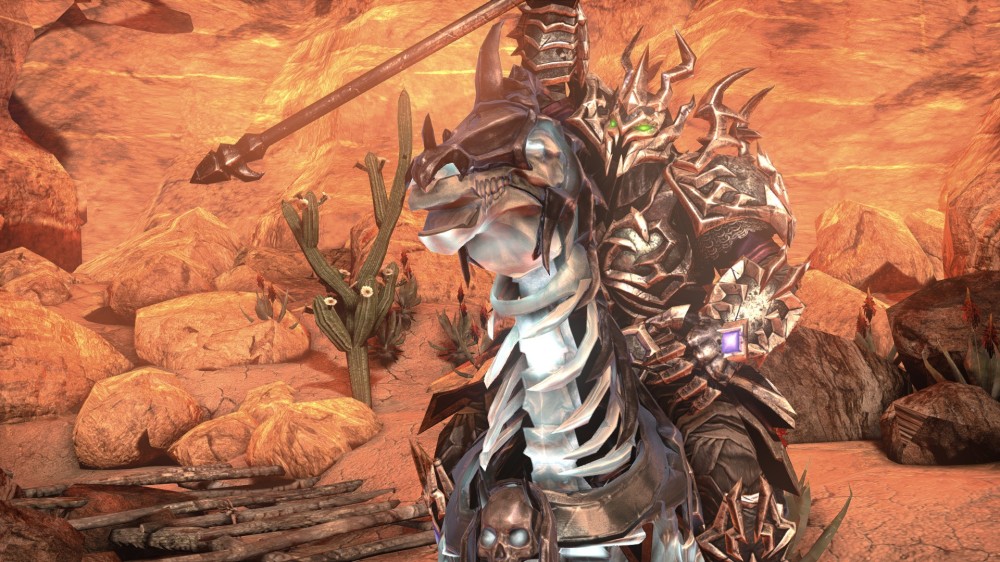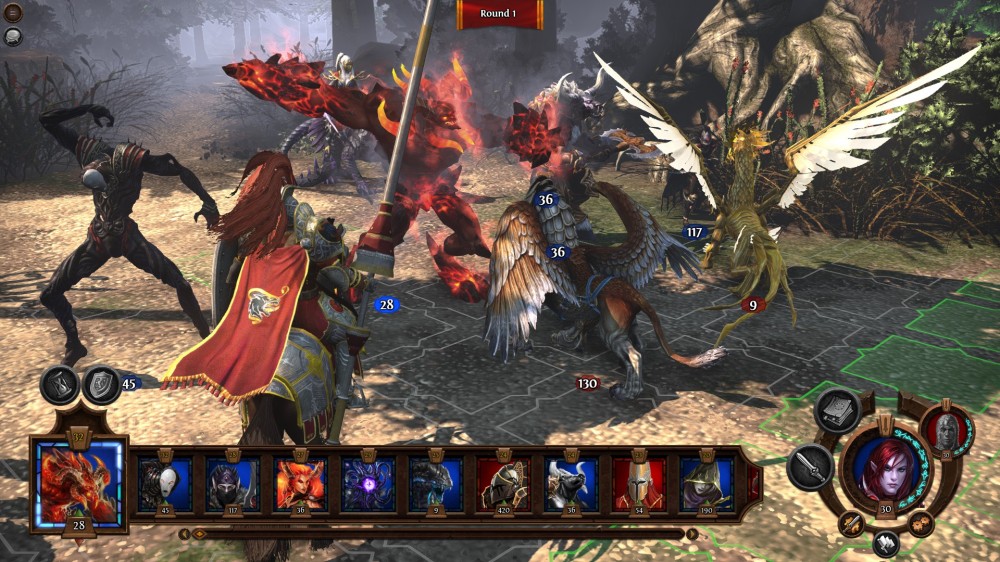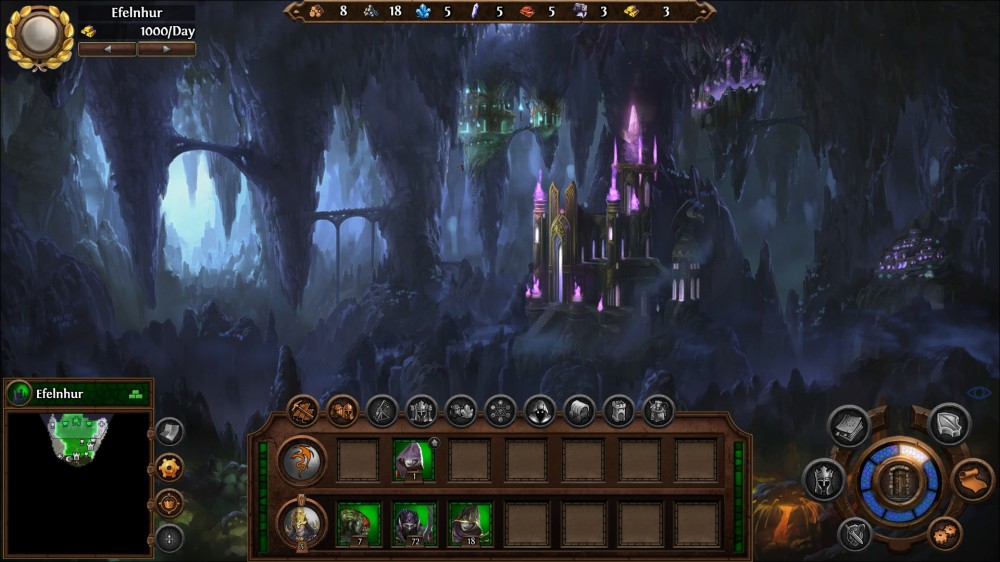Platforms: PC
Reviewed On: PC
Developer: Limbic Entertainment
Publisher: Ubisoft
Singleplayer: Yes
Multiplayer: Yes
The last time I touched a Heroes of Might and Magic game was the sublime Heroes of Might & Magic 3, widely regarded as the best game in the entire franchise. Imagine my surprise to discover that despite some three core games, nine expansions and a good few spin-offs having been put out in the time I’ve been away basically nothing seems to have changed. There’s some small differences here and there, sure, but at its core Heroes 7 is the same game I played all those years ago. Even Call of Duty has changed more than this. Doing some research it seems that the series is in an awkward place where the fans may be stopping it from advancing in a meaningful way, while the developers want to innovate but their new features were quickly dismissed by the core audience, although largely because the core audience were adamant that the new features simply weren’t done very well. The audience seems to have a fair point, because while the core gameplay of Heroes 7 is still a lot of fun, it’s also a game with a lot of problems indicating a developer struggling with the series.
Take, for example, the strange case of the game’s cinematics; they appear to be full rendered 3D scenes with the camera moving around the environment, swooping in to a council made up of various races, headed by one Ivan, a leader seeking to take inspiration from tales of old heroes. Visually it’s not exactly impressive thanks to a lot of rough edges, so-so models and flat design, but it’s not terrible. That is, until they speak. A voice floats through the air and the camera zooms into the character’s face, but their lips aren’t moving. At first I thought it was some sort of horrible glitch and I consulted the forums to see how many others were suffering from it, but on further inspection it seems that this strange ability to speak without moving one’s mouth isn’t a glitch. It bloody spooky, is what it is. It’s like watching a table surrounded by corpses staring into space, the voices being provided by people standing just outside of the camera’s field of vision in some sort of macabre joke. But more precisely it’s almost like watching a cutscene where the developer’s ran out of money at exactly the point where the character’s needed to be animated. There is, of course, still the possibility that these frozen beings are a genuine glitch that’s affecting everyone.
Actually the audio and visual quality of game across the board is surprisingly sub-par for a game with a Triple-A price point. There’s a general lack of detail within the world’s textures, especially notable in combat, that makes the world seem dull and lifeless. Even the creatures suffer from this with uninspiring, drab designs. Then there’s the janky animations seen in combat. Attacks strike with no sense of impact while enemies sort of vaguely sway away from blows in the least convincing demonstration of pain I’ve seen in a long time, while sounds are often out of sync with the on-screen action and even powerful magic attacks lack the necessary oomph. The audio of a huge axe being brought down is a disappointingly muted thud. Topping it all off is the awful voice acting, the kind which suggests the developers lent out of their front door and kidnapped passersbys before forcing them to provide voice-overs, possibly at gunpoint.
There’s a strange discord running through the game in terms of its artistic style, too. The cutscenes are fully rendered in 3D as is the gameplay itself, but then cutscenes during campaigns are done in 2D hand-drawn art, while city screens are also in 2D and feature a completely different style of artwork that paints each town in a classical, bright fantasy style which doesn’t match the rest of the game. There’s no sense of cohesion or thought going into creating the aesthetics. You’ll see the same in the menus, from the perfectly nice looking market screen to the bloody awful thieves guild screen. It’s a lack of polish, really.
Supporting the idea that Limbic Entertainment decided to go relatively risk-free during the development of Heroes VII in an effort to make a game purely for the fans is the lack of a proper tutorial or even a manual. The game simply assumes that you already know what you’re doing. Of course you could argue that nobody would opt to jump into a series when its own its seventh game, but I’d argue that you’d be surprised by how many people will, and the lack of a tutorial to cover the basics, especially since there’s actually quite a bit going on, is a stupid oversight. Still, it’s generally easy enough to learn as you go. The user interface isn’t helping, mind you, with some outstanding displays of idiocy. If you right click on one of your units while on the hero screen, for example, a pop-up appears so you can examine basic stats and at the bottom is a set of icons denoting skills. However, you can’t just mouse over these skills to get more information, because the pop-up will close as soon as you move the mouse. Instead you’ve got to open up the badly name Heropedia and check out the skills from there, creating the need for a second screen where one isn’t needed. Bafflingly during combat you can not only bring up a pop-up by right clicking on a unit but you can also mouse over the skills to get the corresponding information. Meanwhile in the town screen go to build something and you can right click for a brief description, but to get anything of use you need to click the little exclamation mark and once again open up the heropedia. Again, these odd UI designs are not a huge complaint, but shows the game’s lack of polish and cohesion.
At its core, though, that compelling gameplay of the series is still there, keeping me clicking away in a haze of nostalgia. The truth is I while there’s a lot of problems here the Heroes formula has managed to grab me again even after all these years. But for the uninitiated let’s just run over the basics, shall we? On your turn you take control of your hero or heroes and canter around the landscape, looking for resources to hoover up, mines to take control of which will grant you stone, wood or other things once a week, artifacts to seize and more, most of which goes toward fueling the growth of your capital city, plus any extra ones you’ve managed to capture along the way. These cities primary function is pumping out the creatures, monsters and soldiers that form your heroes armies out in the field, with new units becoming available to recruit once a week provided you’ve got the resources needed. There’s a relatively extensive tech tree available to each of the 6-different factions that make up the game, but there’s very few hard decisions to make; most of the time you can build everything, with the biggest decisions usually being whether you want to increase the growth of one unit or another. There’s only a few occasions where you’ll need to choose between one type of creature over another. You can only construct one building per day in any given city, and so a large part of the game is attempting to get to the highest tiers of unit before your adversaries and maintain enough resources to recruit them all every week. Generally speaking, though, nobody usually manages to get too far ahead on the tech tree unless the AI is having one of its many barmy moments. One example included a map where my ally suddenly decided to spend all of his time hoovering up the loose resources, and never seemed to find the two passes into enemy territory until I ventured down them. Once you’ve done everything you can on your turn you click the button on the bottom right of the screen and proceed to let the enemy have their go at it.
While moving around the map you’ll find that most mines, resources and artifacts are guarded by groups of creatures that you need to battle, and of course you’ll occasionally run into enemy heroes and their armies. Combat is also turn-based, taking place on grids where you can command stacks of your creatures to move and attack the enemy’s forces, while your hero can toss in spells and perform direct attacks, too. Tactically your main goal is to position your forces behind the enemy in order to take advantage of the flanking bonus for some serious extra damage, thus combat is largely about trying to flank the enemy without putting your own troops in a bad position while using the occasional piece of scenery to your advantage. However, since even slow creatures can frequently move quite far combat can devolve into stacks of troops walking behind the enemy and stabbing them, and then the enemy stack doing the same thing to them, and so on and so on until victory is achieved. Magic attacks bring some extra depth, though, as you buff up your forces, weaken the enemy and maybe even try to deter their movement with a well placed wall of fire. There’s some creature abilities thrown into the mix, too, in order to stop them all feeling like they should be used almost exactly the same. It’s not exactly deep stuff, but it is quite a lot of fun, hampered just a little bit by the incredibly boring maps that the game loves to have you do battle on.
Eventually you’ll need to assault towns as well, which can sometimes be great and sometimes be kind of a drag. Holed up behind their walls which are likely adorned with a few defensive structures a good seige can be a lot of fun to play, as you’re own weapon of war lays into the walls. Enemies can come out of the gates and any creature capable of flying can leap over and engage in combat, although they risk being swarmed. However, quite often sieges can devolve into boring battles of patience, because without a certain hero skill your seige weapons will attack bits of the wall at random and thus breaking through can become a tiresome chore, especially when you’ve got one or enemy ranged units left on the enemy’s side who won’t budge from their defensive position, understandably.
As you play you’ll recruit more heroes and thus have more armies roaming the landscaping, scampering from here to there. Thankfully there’s a quick-combat option so that you don’t have to play out every battle against weak groups that stand no chance of even damaging your forces before being systematically demolished. The downside is that the quick-combat option isn’t available when fighting enemy heroes, regardless of how tiny their army is.
Through battling the enemy and even visiting specific locations on the map you’ll be able to level up and put points into improving aspects of your heroes using a pleasingly diverse system that gives you some room to either put points into whatever the hero is naturally inclined towards or branch out a little and diversify his or her skills. Skills that heroes are naturally geared towards are easy to spot because those have an extra fourth tier available containing a single, powerful skill. Ones that they aren’t particularly versed in will only have two tiers in comparison to the usual three. Using this you can buff up defense, attack or maybe even make your hero better at exploration by being able to travel further in a single turn and see a greater distance. Some abilities also increase your mayoral skills, since heroes can be appointed mayors of cities in order to convey some extra benefits. It’s a good system.
Other areas of the game, though, feel like they could have done with this same degree of choice being applied, namely city building and army recruiting. As mentioned before you’ve rarely ever got to choose between important buildings in your city, and thus developing your collection of buildings mostly comes down to waiting around for the required resources to finally accrue. You can construct a single building each day, so the only decision you really have to make is what to build first, but even that’s limited based on the tier of the building and whether you’ve met the requirements. Watching your cities grow is a pleasure as new buildings are added to the 2D image until eventually you have a full developed hub, but most of the time it feels like you’re not so much carefully planning a complex construction as you are following the instructions in a LEGO set. Likewise your hero always has enough slots to accommodate each type of unit your city can product, so you’ve never got to pick and choose what you take into combat, the only exception being if you capture a different faction’s city and want to take some of their creatures into battle as well, although the game penalizes you with a drop in morale if you mix faction armies in an effort to stop you simply mixing the very best together and squashing the enemy too quickly. Maybe its time for the series to bring in a wider array of units so that players have to consider what forces to use, perhaps creating heroes with armies better suited to certain tasks.
On top of the levelling system you can also acquire artifacts that will bump up your might, defense, magic and more. They don’t always feel liken they’re making a huge difference, but gather enough powerful ones and you’ll finally start to see some improvement. It’s a shame that these artifacts don’t visually alter your hero, though. Seems like a bit of a missed opportunity, there.
To help improve the pace of the game you can order caravans to transport recruited monsters from one city to another so that your heroes don’t have to travel quite as far to bolster their army, although if you begin attacking the enemy and venture deep into their territory then your nearest friendly city might be quite far away. I found myself enlisting an inexperienced hero to essentially act as a courier for entire armies, shuttling reinforcements back and forth to my primary hero since I’m one of those players who loves to have a single, massive army rather than splitting my forces.
There’s some notable balance problems at the moment, primarily that stacks of cheap units were usually able to easily overwhelm expensive, far harder to acquire monsters with astonishing ease, and that made those so-called powerful units feel pretty lackluster.
And sweet Jeebus those loading times are bloody awful! Running on a Western Digital Caviar Black drive it takes me about two and a half minutes to get from pressing play A on Uplay into a savegame for a relatively small four player skirmish. Once you’ve actually managed to load up the game properly you’ll still spend a lot of time waiting for the slow A.I. to complete their turns, especially in large matches. There’s an option to speed the game up, but that affects you, too. A method to speed up enemy A.I. only would have been greatly appreciated. Speeded up heroes also move with a weird stutter that I found horrible, so I had to turn the speed back down. On large games those load times can grow, sometimes topping two minutes on their own. I also noted stuttering on enemy and allied turns, with some occasional performance drops in other areas, too.
A lot of bugs and glitches are being reported on the Steam forums and other places, including data not being saved, campaign missions being glitched so they can’t be completed, crashes on launch and much more, making the game largely unplayable. On my end I’ve not had many problems, the 1.2 patch having seemingly fixed most of the large issues, but given the sheer amount of complaints it seems obvious that this is a game is still in need of patching thus consider keeping an eye on the forums before you go anywhere near it. One problem I can confirm is that right now the multiplayer seems to be unplayable. Every time I tried it crashed.
The campaign tackles the tale of one Ivan Griffin, Duke of Griffin Duchy, as he seeks council from the other factions within the game regarding a decision he has to make. The advice this council gives him takes the form of stories, creating the perfect excuse to delve into a series of six different campaigns that effectively show off the differences between forces, each of which feels different enough to make them enjoyable. The writing is weak, the plot is poor and there’s a lack of decent characters or acting, but the scenarios themselves are pretty good and the inclusion of set piece moments feels like a nice touch. In total you can probably expect to get up to fifty hours from the campaign. Outside of that you can fire up a quick one on one match with the AI where you can indulge in some combat without all the faffing around with cities, but the main draw is delving into the skirmish mode, picking from an admittedly limited map selection and just playing.
Heroes VII feels like a game being held hostage by the die-hard fanatics amongst the loyal fanbase, who are adamant that the developers make “the game that fans want.”, an idea I’ve always been against in principle because while it’s important to use player feedback a game should always be want the creator wants first and foremost, because left to their own devices die-hard fans will usually stick with what they know before then jumping on Youtube to complain that the latest Call of Duty isn’t innovative. There’s a sensation of a lack of passion here indicating, at least to me, a developer that’s scared to push forward and try to forge a future where Might & Magic Heroes can exist and thrive, a developer that’s scared to try something new in case it angers the loyal fanbase or the overlords at Ubisoft who simply want a game they can consistently sell. Whether Limbic are actually good developers who can bring meaningful progression and good, new ideas to the table remains to be seen. This is the first game of theirs I’ve ever played and their portfolio hardly inspires much confidence. Their work here is rough around the edges and clumsy at times, but through it all shines the enjoyable core foundations of the series. I had fun playing Heroes VII, I really did, and after some patching it will probably be rather good indeed. But after so long away I came back excited to see how the series had changed, and was surprised to find it really hadn’t.
In short, although I’m in no way qualified to say this having been away from the franchise for so long, I believe fans will enjoy it, but will also be left feeling disappointed by it and its low production values. It’s a fun game that has kept me playing for hours on end, but one you might just want to wait for a sale to buy. If you’re a newbie to the series then I don’t see a reason why you can’t jump in. You’ll get the gist of the story and while the lack of tutorials is a problem the basics are easy enough to grasp. Still wait for that sale, though.

![Might_and_Magic_Heroes_VII_deceptive_marketing[1]](https://wolfsgamingblog.files.wordpress.com/2015/10/might_and_magic_heroes_vii_deceptive_marketing1.jpg?w=1000)




One Comment Add yours